Whirlpool GZ5730XRB, GZ5730XRQ, GZ5730XRS, GZ5730XRT, GZ5736XRB Installation Instructions
...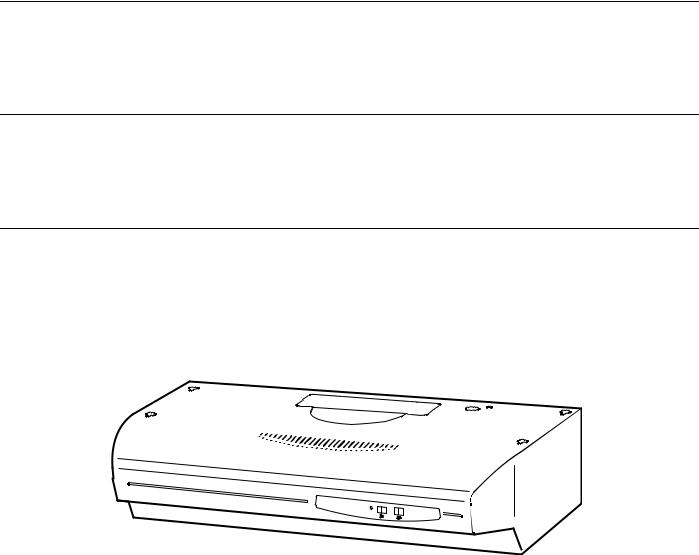
30" (76.2 CM) AND 36" (91.4 CM) CONVERTIBLE RANGE HOOD
Installation Instructions and Use & Care Guide
HOTTE D'ASPIRATION CONVERTIBLE DE 30" (76,2 CM) ET 36" (91,4 CM)
Instructions d’installation et Guide d’utilisation et d’entretien
Table of Contents/Table des matières............................................................................. |
2 |
GZ5730XR Series
GZ5736XR Series
Série GZ5730XR
Série GZ5736XR
IMPORTANT: READ AND SAVE THESE INSTRUCTIONS.
FOR RESIDENTIAL USE ONLY.
IMPORTANT : LIRE ET CONSERVER CES INSTRUCTIONS.
POUR UTILISATION RÉSIDENTIELLE UNIQUEMENT.
9763367B

TABLE OF CONTENTS |
|
RANGE HOOD SAFETY ................................................................. |
2 |
INSTALLATION REQUIREMENTS ................................................ |
4 |
Tools and Parts ............................................................................ |
4 |
Location Requirements................................................................ |
4 |
Electrical Requirements ............................................................... |
4 |
Venting Requirements.................................................................. |
5 |
INSTALLATION INSTRUCTIONS .................................................. |
6 |
Prepare Location.......................................................................... |
6 |
Prepare Range Hood ................................................................... |
7 |
Make Electrical Connection ......................................................... |
9 |
Install Range Hood....................................................................... |
9 |
Complete Installation ................................................................. |
10 |
RANGE HOOD USE...................................................................... |
10 |
Operation.................................................................................... |
10 |
RANGE HOOD CARE ................................................................... |
10 |
Cleaning and Maintenance ........................................................ |
10 |
ASSISTANCE OR SERVICE......................................................... |
11 |
WARRANTY .................................................................................. |
12 |
TABLE DES MATIÈRES |
|
SÉCURITÉ DE LA HOTTE DE CUISINIÈRE ............................... |
13 |
EXIGENCES D'INSTALLATION ................................................... |
15 |
Outils et pièces........................................................................... |
15 |
Exigences d'emplacement......................................................... |
15 |
Spécifications électriques .......................................................... |
15 |
Exigences concernant l'évacuation ........................................... |
16 |
INSTRUCTIONS D'INSTALLATION............................................. |
17 |
Préparation de l'emplacement................................................... |
17 |
Préparation de la hotte............................................................... |
18 |
Raccordement électrique........................................................... |
20 |
Installation de la hotte ................................................................ |
21 |
Achever l'installation .................................................................. |
21 |
UTILISATION DE LA HOTTE ....................................................... |
21 |
Fonctionnement ......................................................................... |
21 |
ENTRETIEN DE LA HOTTE.......................................................... |
21 |
Nettoyage et entretien................................................................ |
21 |
ASSISTANCE OU SERVICE......................................................... |
22 |
GARANTIE..................................................................................... |
23 |
RANGE HOOD SAFETY
Your safety and the safety of others are very important.
We have provided many important safety messages in this manual and on your appliance. Always read and obey all safety messages.
This is the safety alert symbol.
This symbol alerts you to potential hazards that can kill or hurt you and others.
All safety messages will follow the safety alert symbol and either the word “DANGER” or “WARNING.” These words mean:
 DANGER
DANGER
 WARNING
WARNING
You can be killed or seriously injured if you don't immediately follow instructions.
You can be killed or seriously injured if you don't follow instructions.
All safety messages will tell you what the potential hazard is, tell you how to reduce the chance of injury, and tell you what can happen if the instructions are not followed.
2

IMPORTANT SAFETY INSTRUCTIONS
WARNING: TO REDUCE THE RISK OF FIRE, ELECTRIC SHOCK, OR INJURY TO PERSONS, OBSERVE THE FOLLOWING:
■Use this unit only in the manner intended by the manufacturer. If you have questions, contact the manufacturer.
■Before servicing or cleaning the unit, switch power off at service panel and lock the service disconnecting means to prevent power from being switched on accidentally. When the service disconnecting means cannot be locked, securely fasten a prominent warning device, such as a tag, to the service panel.
■Installation work and electrical wiring must be done by qualified person(s) in accordance with all applicable codes and standards, including fire-rated construction.
■Sufficient air is needed for proper combustion and exhausting of gases through the flue (chimney) of fuel burning equipment to prevent backdrafting. Follow the heating equipment manufacturer's guideline and safety standards such as those published by the National Fire Protection Association (NFPA), the American Society for Heating, Refrigeration and Air Conditioning Engineers (ASHRAE), and the local code authorities.
■When cutting or drilling into wall or ceiling; do not damage electrical wiring and other utilities.
■Ducted fans must always be vented outdoors. CAUTION: For general ventilating use only. Do not use to exhaust hazardous or explosive materials and vapors.
CAUTION: To reduce risk of fire and to properly exhaust air, be sure to duct air outside - do not vent exhaust air into spaces within walls or ceilings, attics or into crawl spaces, or garages.
WARNING: TO REDUCE THE RISK OF FIRE, USE ONLY METAL DUCTWORK.
WARNING: TO REDUCE THE RISK OF A RANGE TOP GREASE FIRE:
■Never leave surface units unattended at high settings. Boilovers cause smoking and greasy spillovers that may ignite. Heat oils slowly on low or medium settings.
■Always turn hood ON when cooking at high heat or when flambeing food (i.e. Crepes Suzette, Cherries Jubilee, Peppercorn Beef Flambé).
■Clean ventilating fans frequently. Grease should not be allowed to accumulate on fan or filter.
■Use proper pan size. Always use cookware appropriate for the size of the surface element.
WARNING: TO REDUCE THE RISK OF INJURY TO PERSONS IN THE EVENT OF A RANGE TOP GREASE FIRE, OBSERVE THE FOLLOWING:a
■SMOTHER FLAMES with a close fitting lid, cookie sheet, or metal tray, then turn off the burner. BE CAREFUL TO PREVENT BURNS. If the flames do not go out immediately, EVACUATE AND CALL THE FIRE DEPARTMENT.
■NEVER PICK UP A FLAMING PAN - you may be burned.
■DO NOT USE WATER, including wet dishcloths or towels - a violent steam explosion will result.
■Use an extinguisher ONLY if:
–You know you have a class ABC extinguisher, and you already know how to operate it.
–The fire is small and contained in the area where it started.
–The fire department is being called.
–You can fight the fire with your back to an exit.
aBased on "Kitchen Fire Safety Tips" published by NFPA.
■ WARNING: To reduce the risk of fire or electrical shock, do not use this fan with any solid-state speed control device.
SAVE THESE INSTRUCTIONS
3

INSTALLATION REQUIREMENTS
Tools and Parts
Gather the required tools and parts before starting installation. Read and follow the instructions provided with any tools listed here.
Tools needed
■Level
■Compass or 8" (20.3 cm) circle template
■Flat-blade screwdriver
■Phillips screwdriver
■Pliers
■Metal snips
■Drill
■1¹⁄ " and ¹⁄ " drill bits
■Pencil
■Ruler
■Keyhole saw
■Saber saw
■Vent clamps
Parts needed
■UL listed or CSA approved ¹⁄ " (12.5 mm) strain relief (used with direct wiring only)
■Power supply cable
■7" (17.8 cm) round damper if using 7" (17.8 cm) round vent system
■2 twist-on electrical wire connectors
Location Requirements
IMPORTANT: Observe all governing codes and ordinances.
■Range hood location should be away from strong draft areas, such as windows, doors and strong heating vents.
■Grounded electrical outlet is required. See “Electrical Requirements” section.
■It is recommended that the hood be fastened into solid wood. If you are fastening into drywall or other material, wall anchors or screws with toggle nuts (purchased separately) must be used.
■The range hood is factory set for non-venting (recirculating) installations. For vented installations see “Installation Instructions” section.
■If the range hood will be used as a non-vented installation you will also need to purchase a 30" (76.2 cm) filter kit, Number 4396291 or 36" (91.4 cm) filter kit, Number 4396292 from your dealer.
■All openings in ceiling and wall where range hood will be installed must be sealed.
■For U.S. only: For power cord connected installations, a ULlisted range hood cord connection kit (Part Number HOODPT3) must be used.
Product Dimensions
29 ⁄" (75.9 cm) model: GZ5730 Series
35 ⁄" (91.1 cm) model: GZ5736 Series
7 ¹⁄"
(18.4 cm)
12 ⁄"
(32.1 cm)
20"
(50.8 cm)
Electrical Requirements
IMPORTANT: The hood must be electrically grounded in accordance with local codes and ordinances and with National Electrical Code, ANSI/NFPA 70 (latest edition), or Canadian Electrical Code, CSA C22.1.
If codes permit and a separate ground wire is used, it is recommended that a qualified electrician determine that the ground path is adequate.
A copy of the above code standards can be obtained from:
National Fire Protection Association
One Batterymarch Park
Quincy, MA 02269
CSA International
8501 East Pleasant Valley Road
Cleveland, OH 44131-5575
■A 120 Volt, 60 Hz., AC only, 15-amp, fused electrical circuit is required. A time-delay fuse or circuit breaker is also recommended. It is recommended that a separate circuit serving only this hood be provided.
■Do not ground to a gas pipe.
■Check with a qualified electrician if you are not sure range hood is properly grounded.
■Do not have a fuse in the neutral or ground circuit.
■The range hood must be connected with copper wire only.
■The range hood should be connected directly to the fused disconnect (or circuit breaker) box through flexible armored or nonmetallic sheathed copper cable.
■A UL or CSA listed strain relief must be provided at each end of the power supply cable. Wire sizes (copper wire only) and connections must conform with the rating of the appliance as specified on the model/serial rating plate.
■Wire sizes must conform to the requirements of the National Electrical Code, ANSI/NFPA 70 (latest edition), or CSA Standards C22. 1-94, Canadian Electrical Code, Part 1 and C22.2 No. 0-M91 (latest edition) and all local codes and ordinances.
4
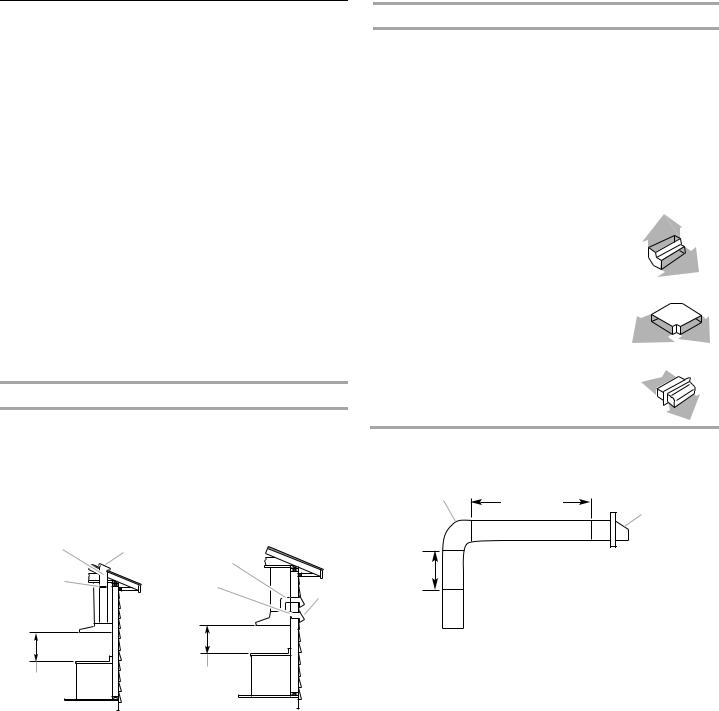
Venting Requirements
■Vent system (if needed) for installation is not included.
■Vent system must terminate to the outdoors, except for nonvented (recirculating) installations.
■Do not terminate the vent system in an attic or other enclosed area.
■Do not use 4" (10.2 cm) laundry-type wall caps.
■Use metal vent only. Rigid metal vent is recommended. Do not use plastic or metal foil vent.
For the most efficient and quiet operation:
■The length of vent system and number of elbows should be kept to a minimum to provide efficient performance. The size of the vent system should be uniform.
■Do not install 2 elbows together.
■Vent system can terminate either through the roof or wall.
■For the most efficient and quiet operation, it is recommended that the range be vented vertically through the roof through 7" (17.8 cm) round vent system.
■Use vent clamps to seal all joints in the vent system.
■Use caulking to seal exterior wall or roof opening around the cap.
Venting Methods
Determine which outside venting method needs to be used. It is recommended that the vent system be installed before installing the range hood.
NOTE: If a non-vented (recirculating) installation is desired, follow instructions in the “Make Electrical Connection” section.
Roof Venting |
Wall Venting |
Calculating Vent System Length
To calculate the length of the system you need, add the equivalent feet (meters) for each vent piece used in the system.
Use 3¹⁄ " x 10" (8.3 cm x 25.4 cm) or 7" (17.8 cm) round vent with a maximum length of 65 ft (19.8 m) for vent system. For best performance, use no more than three 90° elbows. To calculate the length of system you need, add the equivalent feet for each vent piece used in the system. See the following examples.
3¹⁄ " x 10" (8.3 cm x 25.4 cm) Vent System
Vent Piece |
3¹⁄" x 10" (8.3 cm x 25.4cm) |
|
Round |
|
|
3¹⁄ " x 10" (8.3 cm x 25.4 cm) |
5.0 ft |
90° elbow |
(1.5 m) |
|
|
3¹⁄ " x 10" (8.3 cm x 25.4 cm) |
12.0 ft |
flat elbow |
(3.7 m) |
|
|
3¹⁄ " x 10" (8.3 cm x 25.4 cm) |
0.0 ft |
wall cap |
(0.0 m) |
Example vent system
3¹⁄" x 10" |
|
(8.3 x 25.4 cm) |
|
elbow |
Wall cap |
6 ft (1.8 m) |
A |
D |
A |
|
|
|
B |
B |
D |
|
|
|
C |
C |
|
|
|
A.7" (17.8 cm) round vent or a 3¹⁄ " x 10" (8.3 x 25.4 cm) vent through roof
B.Round vent: use 7" (17.8 cm) round damper
(purchased separately)
C.18" (45.7 cm) - 24" (61.0 cm) above cooking surface
D.Roof cap
A.7" (17.8 cm) round vent or a 3¹⁄ " x 10" (8.3 x 25.4 cm) vent through the wall
B.3¹⁄ " x 10" (8.3 x 25.4 cm) through the wall
C.18" (45.7 cm) - 24" (61.0 cm) above cooking surface
D.Wall cap
2 ft
(0.6 m)
Maximum Recommended Length |
= 35 ft (10.7 m) |
1 - 90° elbow |
= 5.0 ft (1.5 m) |
8 ft (2.4 m) straight |
= 8.0 ft (2.4 m) |
1 - wall cap |
= 0.0 ft (0.0 m) |
|
|
Length of 3¹⁄ " x 10" (8.3 cm x 25.4 cm) |
= 13.0 ft (3.9 m) |
system |
|
5
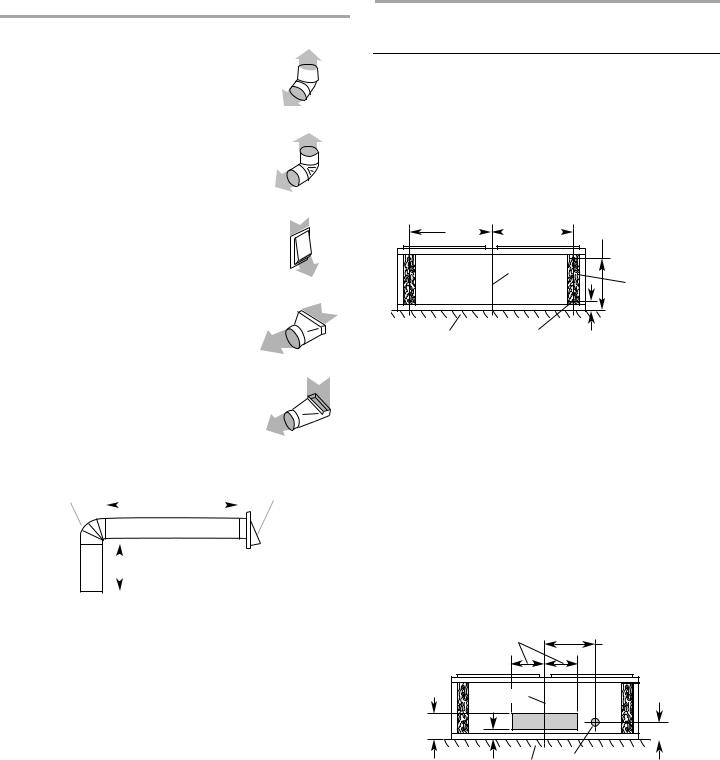
7" (17.8 cm) Vent System
Vent Piece |
|
|
7" (17.8 cm) Round |
|||||||||||
45° elbow |
|
|
2.5 ft |
|
|
|
||||||||
|
|
|
|
|
|
|
|
|
|
(0.8 m) |
|
|
|
|
|
|
|
|
|
|
|
|
|
|
|
|
|
|
|
90° elbow |
|
|
5.0 ft |
|
|
|
||||||||
|
|
|
|
|
|
|
|
|
|
(1.5 m) |
|
|
|
|
|
|
|
|
|
|
|
|
|
|
|
|
|
|
|
7" (17.8 cm) |
|
|
0.0 ft |
|
|
|
||||||||
wall cap |
|
|
(0.0 m) |
|
|
|
||||||||
|
|
|
|
|
|
|
|
|
|
|
|
|
|
|
3¹⁄ " x 10" (8.3 cm x 25.4 cm) |
4.5 ft |
|
|
|
||||||||||
to 7" (17.8 cm) |
|
|
(1.4 m) |
|
|
|
||||||||
|
|
|
|
|
|
|
|
|
|
|
|
|
|
|
3¹⁄ " x 10" (8.3 cm x 25.4 cm) |
5.0 ft |
|
|
|
||||||||||
to 7" (17.8 cm) 90° elbow |
|
|
(1.5 m) |
|
|
|
||||||||
|
|
|
|
|
|
|
|
|
|
|
|
|
|
|
Example vent system |
|
|
|
|
|
|
|
|||||||
90˚ elbow |
|
|
|
|
|
|
|
|
|
|
|
|
Wall cap |
|
|
|
|
|
|
|
|
|
6 ft (1.8 m) |
|
|
|
|
||
|
|
|
|
|
|
|
|
|
|
|
|
|
|
|
|
|
|
|
|
|
|
|
|
|
|
|
|||
|
|
|
|
|
|
|
|
|
|
|||||
|
|
|
|
|
|
|
|
|
|
|
||||
|
|
2 ft (0.6 m) |
|
|
|
|
|
|
|
|||||
|
|
|
|
|
|
|
|
|
|
|
|
|
|
|
|
|
|
|
|
|
|
|
|
|
|
|
|
|
|
Maximum Recommended Length |
= 50 ft (15.2 m) |
|||||||||||||
|
|
|
|
|
|
|
|
|
|
|
|
|
|
|
1 - 90° elbow |
|
|
|
|
= 5.0 ft (1.5 m) |
|||||||||
1 - wall cap |
|
|
|
|
= 0.0 ft (0.0 m) |
|||||||||
8 ft (2.4 m) straight |
|
|
|
|
= 8.0 ft (2.4 m) |
|||||||||
|
|
|
|
|
|
|
|
|
|
|
|
|
|
|
Length of 7" (17.8 cm) system |
|
|
= 13.0 ft (3.9 m) |
|||||||||||
INSTALLATION INSTRUCTIONS
Prepare Location
1.If possible, disconnect and move freestanding or slide-in range from cabinet opening to provide easier access to upper cabinet or rear wall. Slide cardboard or hardboard under range before moving range across floor to avoid damaging floor covering. Otherwise, put a thick covering over countertop, cooktop or range to avoid damage or dirt.
2.Determine which venting method (roof, wall or non-venting) you need to use. This range hood is shipped for non-vented installation.
|
|
|
|
|
|
10¹⁄ " |
A |
|
|
|
A |
|
|
|
|
|
|
(26.7 cm) |
||
|
|
|
|
|
|
cabinet |
centerline |
|
wood shim strips |
||
bottom |
||
|
(recessed cabinet |
|
|
bottoms only) |
wall |
¹⁄ " (3.0 mm) |
1¹⁄ " |
|
pilot holes |
(3.8 cm) |
|
|
|
Hood size |
|
A |
30" (76.2 cm) |
13¹ ⁄" (35.4 cm) |
|
36" (91.4 cm) |
16¹ ⁄" (43.0 cm) |
|
|
|
|
3.Drill four ¹⁄ " (3.0 mm) pilot holes for hood mounting screws. If cabinet has recessed bottom, add wood shim strips on each side.
4.From the following diagrams, select the diagram for your installation.
Vented installations: Cut the vent system and electrical wiring access holes as required.
■If wiring through the top, use location shown in vertical vent system.
■If wiring through the back, use location shown in horizontal vent system.
3¹⁄" x 10" (8.3 x 25.4 cm) rectangular vertical vent system |
|||||
|
5¹⁄ " |
|
|
|
|
|
(13.3 cm) |
|
|
7¹⁄ " |
|
|
|
|
|
|
|
|
|
|
|
|
(19.1 cm) |
|
centerline |
|
|
||
5" |
1 |
¹⁄ |
wall |
1¹⁄ " (3.2 cm) |
2" |
(12.7 cm) |
" |
|
dia. hole |
||
(3.2 cm) |
|
(5.1 cm) |
|||
6
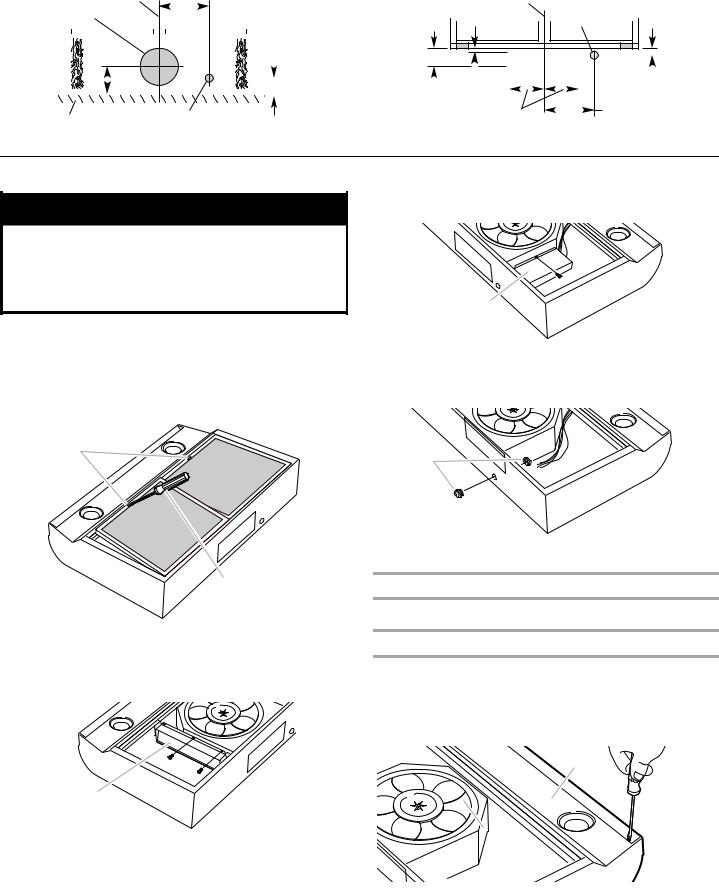
7" (17.8 cm) round vertical vent system |
3¹⁄" x 10" (8.3 x 25.4 cm) horizontal vent system |
|
|
|
|
|
centerline |
|
|
||||||||||
8" (20.3 cm) |
|
|
|
|
|
|
|
7¹⁄ " |
|
|
|||||||
|
|
|
|
|
|
|
|
||||||||||
dia. hole |
|
|
|
|
|
|
|
(19.1 cm) |
|
|
|||||||
|
|
|
|
|
|
|
|
|
|
|
|
|
|
|
|
|
|
|
|
|
|
|
|
|
|
|
|
|
|
|
|
|
|
|
|
|
|
|
|
|
|
|
|
|
|
|
|
|
|
|
|
|
|
|
|
|
|
|
|
|
|
|
|
|
|
|
|
|
|
|
|
|
|
|
|
|
|
|
|
|
|
|
|
|
|
|
|
|
|
|
|
|
|
|
|
|
|
|
|
|
|
|
|
|
|
|
|
|
|
|
|
|
|
|
|
|
|
|
|
|
|
|
|
|
|
|
|
|
|
|
|
|
|
|
|
|
|
|
|
|
|
|
|
|
|
|
|
|
|
|
|
|
|
|
|
|
|
|
|
|
|
|
|
|
|
|
|
|
|
|
|
|
|
|
|
|
|
|
|
wall |
5" |
1¹⁄ " (3.2 cm) |
2" |
|
(12.7 cm) |
dia. hole |
|
|
(5.1 cm) |
||
|
|
|
centerline |
|
|
1¹⁄ " (3.2 cm) |
cabinet front |
dia. hole |
|
|
|
|
|
|
|
|
|
|
|
|
|
|
|
|
|
|
|
|
|
|
|
|
|
|
|
|
|
|
|
|
|
|
|
|
|
|
|
|
|
|
|
|
|
|
|
|
¹⁄ " |
|
|
|
|
|
|
³⁄ " |
||||
|
|
|
|
|
|
|
|
|||||||
|
|
(3.2 mm) |
|
|
|
|
|
|
||||||
3³⁄ " |
|
|
|
|
|
|
(19 mm) |
|||||||
|
|
|
|
|
|
|
|
|
|
|||||
|
|
|
|
|
|
|
|
|
|
|
|
|
||
(9.5 cm) |
5¹⁄ " |
|
|
7¹⁄ " (19.1 cm) |
|
|
|||
|
(13.3 cm) |
|
|
|
|
|
|
|
Prepare Range Hood
 WARNING
WARNING
Excessive Weight Hazard
Use two or more people to move and install range hood.
Failure to do so can result in back or other injury.
1.Set the range hood on a surface such as cardboard or a large towel. Remove the 7" (17.8 cm) round vent plate from top of hood. Set vent plate and mounting screws aside.
4.Remove wiring cover from inside the hood. Set aside cover and mounting screws.
A
A. Wiring cover
2.Remove tape holding standard filters in place. Remove both filters. Insert flat blade screwdriver into slots in filters. Push each filter toward back of range hood, lift out and set aside.
A
B
A.Filter slots
B.Flat blade screwdriver
5.Depending on your installation, remove either top or back wiring knockout and install a ¹⁄" UL or CSA listed strain relief.
A
A. Strain relief
For non-vented installations
Go to “Make Electrical Connection” section.
For vented installations
3.Remove damper/vent connector from inside the hood. Set aside connector, mounting screws and bag containing parts.
1.Remove the five screws holding the light panel in place and set them aside.
2.Disconnect the light assembly wiring connector. Make sure not to disconnect any wires.
3.Remove the light panel and set aside.
A
A
A. Damper/vent connector
A. Light panel
7
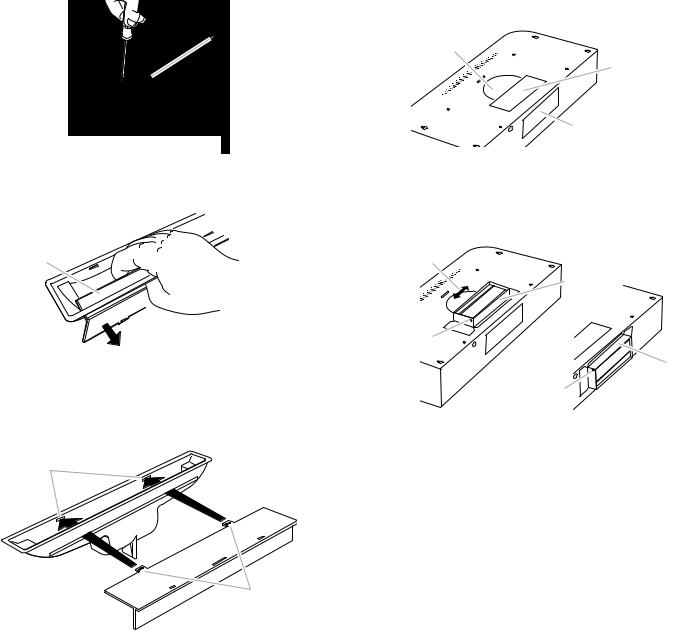
4. Remove the air chute held in place with one screw.
A
A.Air chute
5.Remove baffle from air chute.
A
A.Baffle
6.Rotate baffle and reinsert it back into the air chute so that the baffle tabs fit all the way into slots in the air baffle. This will close off the airflow through the non-vented slots on top of the hood.
A
B
A.Tab slots
B.Tabs
7.Replace air chute.
8.Connect light assembly wiring connector and replace light panel.
NOTE: Make sure not to trap wires between the support fin and light panel.
9.Remove either top or rear rectangular knockout. If using 7" (17.8 cm) round vent, remove both top rectangular knockout and the semicircular knockout.
A
B
C
A.Semicircular knockout
B.Top rectangular knockout
C.Rear rectangular knockout
10. Install damper.
A
C
B
C
Vertical vent |
B |
Horizontal vent |
position |
|
position |
A.Up to 1" (2.5 cm) side to side adjustment
B.Pivot
C.Damper/vent connector
Rectangular vent only:
Attach damper/vent connector over knockout opening. Make sure damper pivot is nearest to top/back edge of hood. Remove tape from damper flap.
NOTE: For horizontal vent systems, it is recommended that the rectangular ventwork be attached to the damper/vent connector and sealed with vent clamps before installing the hood.
Round vent only:
Replace round vent plate removed in step 1 of “Prepare the Hood” section.
Install a 7" (17.8 cm) round damper (must be purchased separately). The damper flap must open freely in the direction on airflow (away from range hood).
NOTE: Damper/vent connector and round vent plate can be installed up to 1" (2.5 cm) on either side of hood center if ventwork is off-center. In extreme off-center installations, one end of the vent connector may need to be trimmed to clear the electrical strain relief.
8
